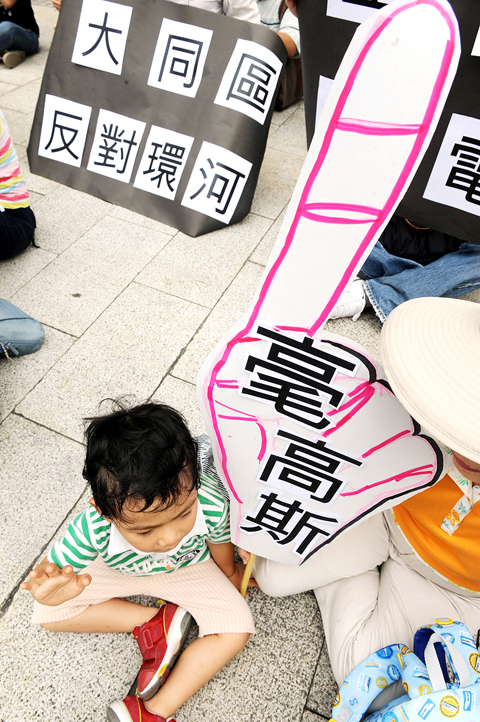Representatives of environmental groups gathered in front of the Environmental Protection Administration (EPA) yesterday to urge the government to lower electromagnetic wave safety standards to a maximum of 1 milli-Gauss (mG).
The agency is considering lowering electromagnetic wave safety standards by 10 percent for “sensitive regions” such as schools, hospitals and residential areas, but the activists said that was not enough.
Taiwan Electromagnetic Radiation Hazard Protection and Control Association chairwoman Chen Chiao-hwa (陳椒華) said the EPA was considering lowering the standard for sensitive areas from 833mG to 83.3mG.

PHOTO: CNA
“From WHO data, we know that advanced countries such as the US and Switzerland have an electromagnetic wave safety limit of 1mG. We fear that as Hsiao is on the EPA’s expert panel, his statement could cause a public misunderstanding,” she said.
She was referring to a recent remark by National Taiwan University of Science and Technology electric engineering assistant professor Hsiao Horng-Ching (蕭弘清) that even if an environment or location had an electromagnetic wave level of 8,300mG, there would be little harm to human health.
“Even at 83.3 milli-Gauss, people are still exposed to high health risks and are likely to develop chronic illnesses such as cancer, or give birth to children with mental retardation or other birth defects,” Chen said.
The environmental groups urged the government to follow the example set by other countries and set the nation’s safety limit to 1mG.
Air Quality Protection and Noise Control Director-General Hsieh Yen-ju (謝燕儒) said the EPA was not ready to decide on whether to lower the limit.
“To make sure we cover all the bases, we will hold more meetings with environmental groups, the National Communications Commission, the Department of Health and media representatives soon,” Hsieh said.
As for the debate over 1mG and 83.3mG standards, Hsieh said that since every country is different, the EPA would collect more information to determine what was best for Taiwan.

ANOTHER EMERGES: The CWA yesterday said this year’s fourth storm of the typhoon season had formed in the South China Sea, but was not expected to affect Taiwan Tropical Storm Gaemi has intensified slightly as it heads toward Taiwan, where it is expected to affect the country in the coming days, the Central Weather Administration (CWA) said yesterday. As of 8am yesterday, the 120km-radius storm was 800km southeast of Oluanpi (鵝鑾鼻), Taiwan’s southernmost tip, moving at 9kph northwest, the agency said. A sea warning for Gaemi could be issued tonight at the earliest, it said, adding that the storm is projected to be closest to Taiwan on Wednesday or Thursday. Gaemi’s potential effect on Taiwan remains unclear, as that would depend on its direction, radius and intensity, forecasters said. Former Weather Forecast

As COVID-19 cases in Japan have been increasing for 10 consecutive weeks, people should get vaccinated before visiting the nation, the Centers for Disease Control (CDC) said. The centers reported 773 hospitalizations and 124 deaths related to COVID-19 in Taiwan last week. CDC Epidemic Intelligence Center Director Guo Hung-wei (郭宏偉) on Tuesday said the number of weekly COVID-19 cases reported in Japan has been increasing since mid-May and surpassed 55,000 cases from July 8 to July 14. The average number of COVID-19 patients at Japan’s healthcare facilities that week was also 1.39 times that of the week before and KP.3 is the dominant

The Chinese Communist Party’s (CCP) working group for Taiwan-related policies is likely to be upgraded to a committee-level body, a report commissioned by the Mainland Affairs Council (MAC) said. As Chinese President Xi Jinping (習近平) is increasingly likely to upgrade the CCP’s Central Leading Group for Taiwan Affairs, Taiwanese authorities should prepare by researching Xi and the CCP, the report said. At the third plenary session of the 20th Central Committee of the CCP, which ended on Thursday last week, the party set a target of 2029 for the completion of some tasks, meaning that Xi is likely preparing to

US-CHINA TRADE DISPUTE: Despite Beijing’s offer of preferential treatment, the lure of China has dimmed as Taiwanese and international investors move out Japan and the US have become the favored destinations for Taiwanese graduates as China’s attraction has waned over the years, the Ministry of Labor said. According to the ministry’s latest income and employment advisory published this month, 3,215 Taiwanese university graduates from the class of 2020 went to Japan, surpassing for the first time the 2,881 graduates who went to China. A total of 2,300 graduates from the class of 2021 went to the US, compared with the 2,262 who went to China, the document showed. The trend continued for the class of 2023, of whom 1,460 went to Japan, 1,334 went to